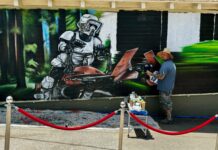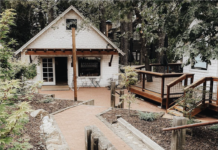One of the joys of living in Idyllwild is our freedom from the usual trend of modern resort towns toward suburban sprawl and congestion. I take special pleasure in discovering spots that have reverted to an earlier, more primitive condition. One such place is the recently dedicated Roe Memorial Grove on the Idyllwild Arts campus.
Nestled between a meadow and Strawberry Creek, it’s shaded by stately oaks and pines and calmed by sounds of flowing water or breeze slithering through pine needles. Though the quiet is occasionally punctuated by voices of visiting squirrels and birds, the distant hum of a passing vehicle, or the faint clatter of domestic life along Idyllmont Road beyond the creek, the Roe Grove today evokes its distant past.
For centuries, especially after 1500, when Lake Cahuilla in Coachella Valley dried up and forced food-seeking Cahuilla bands farther into the mountains, the only human sounds to be heard here were the conversations and tools of native hunters and acorn gatherers in seasonal encampments.
Perpetual serenity was interrupted around 1870, when sheepherders arrived seeking refuge from recurring drought in the valleys below. An 1874 report found up to 3,000 head of sheep here.
Further intrusions followed in rapid succession. In 1876, Joseph Crawford went for the fast buck by scraping out a crude wagon road up the mountain from the San Jacinto River bottomland. He charged a toll to loggers arriving to exploit the forest farther up in Strawberry Valley. Tollgate Road still traces Crawford’s route past the meadow bordering the Roe Grove.
Seven years later, Angelo Domenigoni of Diamond Valley homesteaded the area, known as Domenigoni Flat, adding to the occasional rumbles from passing ox- or mule-drawn lumber wagons. In 1888, timber baron Anton Scherman induced San Diego County — Riverside County was still five years from creation — to revoke Crawford’s toll franchise. With free public access, summer traffic became a flood.
The increasing congestion peaked in 1893 with the appearance of a small settlement called Rayneta. Its focal point was the general store and post office, which George Hannahs opportunistically erected. Locating where the road crossed Strawberry Creek (and still crosses today as the campus entrance) positioned him to capture the business of arriving campers.
In August 1900, a portentous new sound echoed across Domenigoni Flat, as Walter Lindley drove the first automobile into Strawberry Valley. It was a stunt to publicize his impending new sanatorium up the road at a site soon to become known as Idyllwild.
Hannahs saw the handwriting on the wall and built a new cutoff from the road to Lake Hemet that would be easier for cars to negotiate than the old Crawford Road. Then he shut down his store and retreated to Idyllwild in 1901. This resulted in Rayneta’s demise and relieved the traffic along the meadow on Domenigoni Flat, but only a bit.
Things only got noisier in 1909, when down on the lower slopes a new, improved road from Hemet was built. By 1919, traffic was so heavy, Riverside County imposed the infamous one-way controls that gave motorists only 90 minutes to traverse the grade or get off the road and give way to oncoming traffic.
The meadow then sat beside the busiest road on the Hill until 1929, when today’s highway route was opened, which diverted essentially all traffic beyond Middle Ridge. The regained tranquility was reinforced in 1946, when Max Krone and his University of Southern California associates bought the 340-acre tract that would house the new Idyllwild School of Music and the Arts.
Thus, the Idyllwild Arts campus enveloped and protected the Roe Grove, which has returned to a quiet creekside retreat once more.









